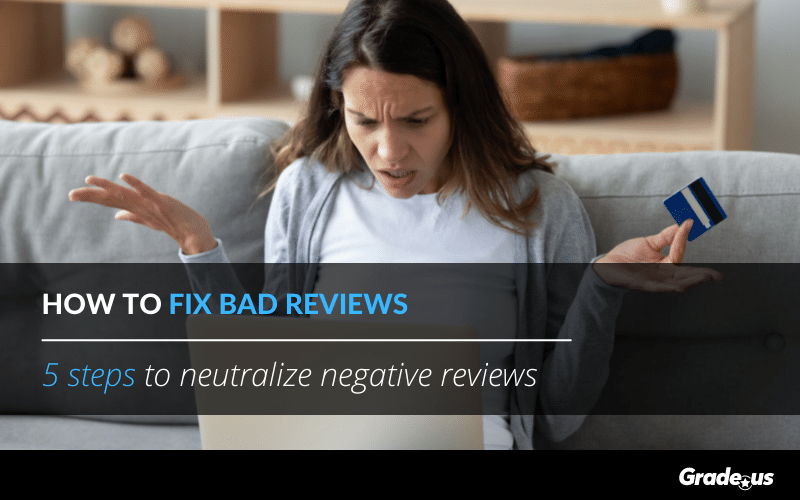It’s the worst-case scenario.
Several customers have just written negative reviews about your business. You’ve worked hard to provide them with exceptional service. It seemed like they were happy.
Only they’re not.
They’re unhappy, and now, instead of discussing it with you directly, they’ve decided to publicly share damaging feedback about your business for the world to see. You stand to lose a lot of customers if you don’t do something fast.
The question is, what?
Why you need to fix bad reviews
The damage from negative reviews compounds over time.
First, there’s the unhappy customer. In 1979, the Technical Assistance Research Program (TARP) at Harvard University published its report, Consumer Complaint Handling in America: Final Report. In the report, they made an interesting discovery about Coca-Cola customers.
“Satisfied Coca-Cola complainants told an average of four to five people about their positive experience, while dissatisfied complainants told an average of nine to 10 people about their negative experience.” – emphasis added
Just one problem.
It’s not 1979 anymore. According to Pew Research:
“Among adult Facebook users, the average (mean) number of friends is 338, and the median (midpoint) number of friends is 200. In other words, half of all Facebook users have more than 200 friends, and half have less than 200.”
Social media wasn’t a mainstream interest in the 1970s. Today, a single status update that’s shared and made public can work its way around the world, to millions of people, in less than an hour.
Don’t take my word for it.
Dave Carroll and his band, Sons of Maxwell, began a week-long tour of Nebraska. He decided to fly with United; unfortunately, United employees destroyed his band’s musical equipment.
“On that first leg of the flight we were seated at the rear of the aircraft and upon landing and waiting to deplane in order to make our connection a woman sitting behind me, not aware that we were musicians cried out: “My god they’re throwing guitars out there.” Our bass player Mike looked out the window in time to see his bass being heaved without regard by the United baggage handlers. My $3500 710 Taylor had been thrown before his.
I immediately tried to communicate this to the flight attendant who cut me off saying: “Don’t talk to me. Talk to the lead agent outside.” I found the person she pointed to and that lady was an “acting” lead agent but refused to talk to me and disappeared into the crowd saying “I’m not the lead agent.”
At the time, United didn’t care.
So Dave wrote a song called “United Breaks Guitars” about United’s poor customer service, and he posted it on YouTube. That video received 21 million views and was shared all over the world, including this article.
https://www.youtube.com/watch?v=5YGc4zOqozo
Dave wrote a book about his experience, and he created a website (UnitedBreaksGuitars.com). He’s written scathing reviews about how United treats its customers.
This is one person.
Dave’s story may seem like the exception, but it’s actually the rule. Review platforms like Yelp, social media platforms like Twitter, and search engines like Google give reviews significant visibility.
The longer your negative reviews go unanswered, the more harm it does to your business.
Want to fix your bad reviews? You'll need a system
I’m about to show you a step-by-step system you can use to deal with negative reviews in your business. It’s not a magic bullet, and it won’t instantly make all of your negative reviews disappear.
That’s make-believe.
Instead, we’ll look at a practical methodology you can customize to address negative reviews that are minor to severe. This is a system that’s designed for beginners and advanced marketers. In a future post, I’ll share more advanced strategies and tactics you can use to counter or neutralize negative reviews for good.
Let’s dive in.
Step #01: Sort your negative reviews
You’ll want to sort your reviewers into four buckets.
- Reviewers who are satisfied and happy
- Genuinely unhappy reviewers
- Unhappy reviewers who are abusive or toxic
- Malicious reviewers looking to hurt or harm your business
This sorting process is essential because it helps you to respond appropriately. When it comes to dealing with negative reviews, you’ll need the right approach.
- Most customers should receive a word of thanks for their trust and support.
- Some customers should be addressed immediately with kindness and empathy.
- Other customers should be monitored carefully.
- A few customers should be avoided and reported, their feedback buried and ignored.
When you sort reviewers, you ensure that you’re spending time with reviewers who are reasonable and willing to reconcile with you. You’ll want to respond to as many of your reviewers as you can; just be sure to screen those who are toxic, abusive, or malicious.
Step #02: Fix the underlying issues
You’ve segmented your reviewers; now, take a look at the underlying issues they’ve mentioned. Are reviewers complaining about:
- Pricing
- Delivery
- Performance
- Fulfillment
- Expectations
- Customer service
You’re looking for trends.
Once you’ve identified a list of trends, you’ll need to come up with a solution; use the feedback from customer reviews to refine your solution.
Do your best to be thorough.
Test your solution with a customer segment, then request feedback from customers. Continue to iterate until you’ve addressed the core issues and you aren’t receiving the same complaints from your cohort or focus groups.
Repeat this process until you’ve addressed the trends you’ve identified in your research.
At this point, you’re ready to win customers back.
Step #03: Create your ‘win back’ campaign
Your ‘win back’ campaign needs several ingredients to be successful. These ingredients have a huge impact on if and how your reviewers will respond.
Here’s a list of the ingredients you’ll need:
- A sincere apology: Your customers may feel they’ve been wronged. If you want to restore your relationship with customers, an apology is an essential component. Just make sure you’re using the right apology language, or you may make things worse. Use your customer’s feedback to identify the apology language you should use.
- An irresistible offer: This offer should be too good for reviewers to pass up. These offers should only be available to the person who wrote the review, you’ll want to verify this during the negotiation process. This is really important as you’ll see later.
- An unbelievable experience: Wow these customers when they return to your business. It is critical that you take the opportunity to make things right. Go above and beyond; give your best employees a chance to take the lead on this.
- Requesting feedback: Be transparent with customers. Let them know that their review had a significant impact on your business. Outline the changes you’ve made to make things right, then ask them for their feedback.
Not sure what to say?
Here’s a ‘win back’ template you can use to request customer feedback.
Hi [Name],
I’m so sorry you had the experience you did with us the first time. I want to thank you for the chance to make things right.
In your first review, you said, “[insert direct quote from their review].”
Did we do better this time around?
I’m grateful for any feedback you can share with us to help us improve.
Thanks for being so gracious,
[Signature]
Can you see what’s happening?
This template includes:
- An apology
- Gratitude
- A direct quote (showing that you’re listening)
- A feedback request
- Your signature (with contact information)
It’s concise, precise, and focused.
Step #04: Create response templates and protocols for customer buckets
Remember our reviewer buckets?
- Reviewers who are satisfied and happy
- Genuinely unhappy reviewers
- Reviewers who are unhappy but abusive
- Malicious reviewers looking to hurt your business
We’re going to create response protocols for each group or segment.
- For satisfied and happy reviewers: You create a response that thanks them for their business and welcomes them back.
- For genuinely unhappy reviewers: You deploy your ‘win back’ campaign. You provide them with incentives discussed privately to restore the relationship.
- For unhappy but abusive reviewers: You’ll need to approach the issue on a case-by-case basis. Do you want these customers back in your business? Or would you prefer to let them go? It’s something you’ll need to decide for yourself. If you choose to move forward, I’d recommend using a different offer with your ‘win back’ campaign if they become predatory or vengeful.
- For malicious reviewers, don’t engage with them directly if you can avoid it. Monitor their feedback and report them to the proper authorities. Keep your responses factual, clinical, and objective if you need to engage with them. Document and save all communication with these customers, whether it’s a screenshot, video, or documentation.
Not sure where to start?
Here’s a list of templates you can use to set things up for your responses.
- 44 Unique Email Templates for Requesting Online Reviews
- How To Respond To Negative Reviews
- 11 Review Response Templates For Great Review
- 60 Review Request Text Templates To Get Google Reviews
- 40 Situational SMS Templates For Requesting Reviews
- 61 Email Review Request Subject Line Templates
- 10 Review Request Scripts For Your Support and Sales Team
Customize these templates so they’re a perfect fit for your business. Create a response for your happy and unhappy customers, exercising more caution with toxic or abusive customers.
Step #05: Request reviews from customers
It should be easy to send out your new review requests if you’ve segmented these customers properly. Ideally, your review requests should include an apology, a thank you, a direct quote, and your feedback request. You’ll want to send this to your customers using the contact information you have on hand. It’s easier to work with review platforms that ask customers to use their real names (i.e., Yelp).
Here’s another important detail.
You’ll want to prioritize review platforms that are most visible in search results. If your Yelp, Google, and TripAdvisor reviews consistently appear in Google’s search results, it’s good to focus your attention there first. Send customers to these review platforms when you share your feedback link.
When you request reviews, make sure customers know it’s okay to say No.
A good rule of thumb would be to send your customers one to three review requests oriented around a specific theme.
- How did we do?
Subject: {First.Name} How did we do?
Body:
{First.Name},
This is {Your Name}, [Title] at [Company]; I’m checking in with you personally to see how we did. I’m not happy that we failed to meet your expectations previously, and I want to make sure we made this right for you this time.
Did we succeed?
Please share your feedback with us.
[Signature]
2. Did we make you happy?
Subject: {First.Name}, Did we make you happy?
Body:
{First.Name},
This is {Your Name}, [Title] at [Company]; I’m writing to ask you one question.
Did we make you happy?
You’ve given us a second chance to make things right with you, and I want to make sure that we do just that. What can we do to make your experience with us a happy one?
Please share your feedback with us.
[Signature]
3. What can we improve for you?
Subject: {First.Name}, What can we improve for you?
Body:
{First.Name},
This is {Your Name}, [Title] at [Company]. I want to thank you for the opportunity you’ve given us to make things right. I saw that [Employees] took care of you; did they go above and beyond for you?
What can we do to improve?
What can we do to restore our relationship with you?
Please share your feedback with us.
[Signature]
You can send customers these review requests about one to three days apart, but don’t spam them if they choose to ignore your requests. If you’d like to improve the conversion ratio of your review requests, a face-to-face or personalized request will work better than an autoresponder sequence.
However, if you need to scale these review requests, software with autoresponder functionality is the best approach.
What about your other customers?
You should continue to request reviews from your new customers. Just be sure to prioritize the review sites that are visible in Google’s search results first. Ask all of your customers for reviews to avoid accusations of bias.
Fixing bad reviews requires a system
You can fix the worst-case scenario.
Several customers have just written negative reviews about your business. You’ve worked hard to provide them with exceptional service. It seemed like they were happy.
Only they’re not.
They’re unhappy, and now, instead of discussing it with you directly, they’ve decided to publicly share damaging feedback about your business for the world to see. You stand to lose a lot of customers if you don’t do something fast.
This isn’t the end of the road.
You can rebuild; you have the technology. Use the systems, strategies, and tactics I’ve laid out, and you’ll find it’s easy to counter, repair, and rebuild your review portfolio, one negative review at a time.









